Investing in the Future
- Share via
Analysts measure America’s global status nowadays by what it owes other nations and how much more it buys abroad than it sells. Comes now a more subtle yardstick known as the genome one that can let the United States resume its role of improving technology and serving humanity.
Genome is the collective term for 100,000 human genes. Among them, those genes contain every hereditary trait in the human race. It was just over 30 years ago that scientists first dimly understood that millions of combinations of a form of nucleic acid, DNA, somehow control heredity. Now they know that defective genes in the building blocks of DNA probably pass cancer, diabetes and more than 3,000 other diseases--or at least a vulnerability to those diseases--from one generation to another.In the space of a generation, researchers have even discovered how to find these defective genes, but it is a laborious business that can consume years and still fail.
As with any search, finding the genes would be easier with a map. Biologists now think that they have reached a point in their research at which they can do that--draw a guide to all 100,000 genes in the genome. In the laboratories, that is known as mapping, which has been described as the equivalent of a map with every city and town in the country on it. The next step is sequencing--the equivalent of a street map of each of those cities and towns.
The implications of this for human beings and their struggle to overcome the ravages of disease are both staggering and breathtaking. And last week the National Academy of Sciences in Washington concluded that the mapping project should begin at once.
The academy report says that the work can be completed in 15 years at a cost of about $3 billion --about a dollar for every nucleotide that forms a link in the structure of genes. The cost may be far lower. Some laboratories talk of a cost of 6 to 8 cents per link.
As so often happens these days, a path to cures for diseases that have plagued humans through recorded history has been instantly blocked by arguments over who might draw the map. Some critics oppose the project as big science, arguing that small science is better--as though there were nothing in between. Other arguments, including one about whether sequencing is really necessary once you have the map, seem to involve mostly money. The most serious, ludicrous and potentially tragic of these pits the genome of the biologists against the superconducting supercolliding atom smasher of the particle physicists--as though the nation must choose between them.
True, the United States is strapped by $1.4 trillion in new debt generated since 1981. Certainly taxes have been reduced, with no permanent recuperative effect on the economy, by far more than enough to afford any number of genome projects.
But grieving over past mistakes uses up time that should be spent looking toward the future. Despite the huge debt, the atom smasher and the genome map offer a chance to invest in tangible symbols of a new direction for the United States rather than in pipe dreams of impervious nuclear defenses. Some of the money, in fact, could well come from the inflated budget for research on “Star Wars” defenses.
Congress should put its money down on both the genome and the super collider to let the world know that the United States maintains an intense interest in the future.






